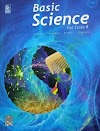Exercise
A. Answer the following in not more than 20 words.
What would you expect in the following cases?
(a) A plastic ruler is rubbed vigorously with a woollen cloth.
(b) A glass rod rubbed with a piece of silk is brought near a negatively charged paper cylinder.
(c) A positively charged rod is moved slowly towards an uncharged paper cylinder, which is suspended by a string, until the rod touches the cylinder.
(d) A negatively charged body is brought in contact with the disc of a positively charged electroscope.
(e) Someone touches the disc of a negatively charged electroscope.
B. Answer the following in not more than 40 words.
1. Explain how a piece of Styrofoam gets charged when it is rubbed with a piece of paper.
2. When a charged rod is moved towards an uncharged paper cylinder suspended by a string, the cylinder gets attracted to the rod initially, and then moves away with a jerk. Explain why.
3. Why do the leaves of a gold-leaf electroscope diverge when a charged body is brought in contact with its disc? Do they always diverge to the same extent?
4. What happens to the charge on an electroscope when its disc is connected to that of an uncharged electroscope with the help of a conducting wire? What happens to the leaves of the two electroscopes?
5. What are lightning conductors?
C. Answer the following in not more than 100 words.
1. Mention three ways by which a body can be charged. Describe an activity to illustrate how a body can be charged by induction. What would happen if you moved the rod away before separating the spheres?
2. With the help of a diagram, describe a gold-leaf electroscope.
3. How would you use an electroscope to determine the nature of the charge (positive or negative) on a body?
4. How does lightning occur?
D. Choose the correct option in each of the following
1. When two bodies are rubbed against each other.
(a) they acquire equal and opposite charges
(b) they acquire similar charges
(c) one body acquires a charge and the other remains uncharged
(d) they acquire different amounts of charge
2 When a negatively charged rod is brought close to two metal spheres which are in contact with each other, and the spheres are separated in the presence of the rod.
(a) the sphere close to the rod acquires a negative charge and the other sphere acquires a positive charge
(b) the two spheres acquire the same charge
(c) the sphere close to the rod acquires a positive charge and the other sphere acquires a negative charge
(d) both spheres remain uncharged
3. Which of the following statements is true?
(a) A charged body attracts an uncharged body, but repels a charged body.
(b) A charged body repels a body carrying a similar charge, but attracts a body carrying the opposite charge, as well as a body carrying no charge.
(c) A charged body attracts another charged body, but repels an uncharged body.
(d) A charged body attracts another body, irrespective of whether it is charged or uncharged
4. A gold-leaf electroscope can be used
(a) only to detect a charge
(b) only to find the nature of a charge
(c) only to measure a charge
(d) to detect, measure and find the nature of a charge
5. If a plastic ruler is used to connect the disc of a charged electroscope, A, with that of an uncharged electroscope, B, the
(a) divergence of the leaves of A decreases
(b) divergence of the leaves of A remains the same
(c) leaves of B also diverge
(d) divergence of the leaves of A increases
6. When an uncharged body touches a charged body, the
(a) uncharged body acquires a similar charge
(b) uncharged body acquires an equal and opposite charge
(c) charged body loses its charge
(d) uncharged body remains uncharged
7. Charge flows from a charged body to an uncharged one
(a) until the entire the charge from one flows into the other
(b) until they both carry the same charge
(c) until they both become uncharged
(d) continuously
E. Complete the following.
1. Electrons carry charge.
2. While testing for charge, is used as a proof for charge.
3. The force with which two similar charges repel each other depends on the. of charge they carry.
4. The flow of charge through air or a gas is called an
5. A lightning conductor allows charge to harmlessly flow to the










No comments:
Post a Comment